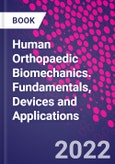Human Orthopaedic Biomechanics: Fundamentals, Devices and Applications covers a wide range of biomechanical topics and fields, ranging from theoretical issues, mechanobiology, design of implants, joint biomechanics, regulatory issues and practical applications. The book teaches the fundamentals of physiological loading and constraint conditions at various parts of the musculoskeletal system. It is an ideal resource for teaching and education in courses on orthopedic biomechanics, and for engineering students engaged in these courses. In addition, all bioengineers who have an interest in orthopedic biomechanics will find this title useful as a reference, particularly early career researchers and industry professionals.
Finally, any orthopedic surgeons looking to deepen their knowledge of biomechanical aspects will benefit from the accessible writing style in this title.
Please Note: This is an On Demand product, delivery may take up to 11 working days after payment has been received.
Table of Contents
1. Introduction: From Mechanics to Biomechanics
2. Mechanical Properties of Biological Tissues
3. Orthopaedic Biomechanics: Stress Analysis
4. Orthopaedic Biomechanics: Multibody Analysis
5. Fundamentals of Mechanobiology
6. Bone Biomechanics
7. Muscle Biomechanics
8. Ligaments and Tendons Biomechanics
9. Cartilage Biomechanics
10. Meniscus Biomechanics
11. Intervertebral Disc Biomechanics
12. Biomechanics of the Hip Joint
13. Biomechanics of the Knee Joint
14. Biomechanics of the Spine
15. Biomechanics of the Shoulder Joint
16. Biomechanics of the Ankle Joint
17. Biomechanics of Wrist and Elbow
18. Biomaterials and Biocompatibility
19. Hip Prosthesis: Biomechanics and Design
20. Knee Prosthesis: Biomechanics and Design
21. Spinal Implants: Biomechanics and Design
22. Shoulder Prosthesis: Biomechanics and Design
23. Devices for Traumatology: Biomechanics and Design
24. Regeneration and Repair of Ligaments and Tendons
25. Biomechanical Requirements for Certification and Quality in Medical Devices
26. Clinical Evaluation of Orthopaedic Implants
27. Computer-Assisted Orthopaedic Surgery
28. Experimental Orthopaedic Biomechanics
29. Challenges in the Anatomical Modeling of the Musculoskeletal System
30. Joint Kinematics Through Instrumented Motion Analysis
31. Fluoroscopy
32. Finite Element Analysis in Orthopaedic Biomechanics
33. Rigid-Body and Musculoskeletal Models
34. The Use of Computational Models in Orthopaedic Biomechanical Research








